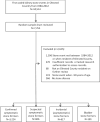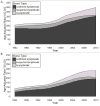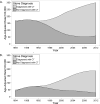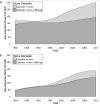The Changing Incidence and Presentation of Urinary Stones Over 3 Decades
- PMID: 29452705
- PMCID: PMC5849397
- DOI: 10.1016/j.mayocp.2017.11.018
The Changing Incidence and Presentation of Urinary Stones Over 3 Decades
Abstract
Objective: To evaluate trends in the incidence of kidney stones and characteristics associated with changes in the incidence rate over 3 decades.
Patients and methods: Adult stone formers in Olmsted County, Minnesota, from January 1, 1984, to December 31, 2012, were validated and characterized by age, sex, stone composition, and imaging modality. The incidence of kidney stones per 100,000 person-years was estimated. Characteristics associated with changes in the incidence rate over time were assessed using Poisson regression models.
Results: There were 3224 confirmed symptomatic (stone seen), 606 suspected symptomatic (no stone seen), and 617 incidental asymptomatic kidney stone formers. The incidence of confirmed symptomatic kidney stones increased from the year 1984 to 2012 in both men (145 to 299/100,000 person-years; incidence rate ratio per 5 years, 1.14, P<.001) and women (51 to 217/100,000 person-years; incidence rate ratio per 5 years, 1.29, P<.001). Overall, the incidence of suspected symptomatic kidney stones did not change, but that of asymptomatic kidney stones increased. Utilization of computed tomography for confirmed symptomatic stones increased from 1.8% in 1984 to 77% in 2012; there was a corresponding higher increased incidence of symptomatic small stones (≤3 mm) than of larger stones (>3 mm). Confirmed symptomatic kidney stones with documented spontaneous passage also increased. The incidence of kidney stones with unknown composition increased more than that of stones with known composition.
Conclusion: The incidence of both symptomatic and asymptomatic kidney stones has increased dramatically. The increased utilization of computed tomography during this period may have improved stone detection and contributed to the increased kidney stone incidence.
Copyright © 2017 Mayo Foundation for Medical Education and Research. Published by Elsevier Inc. All rights reserved.
Figures




References
Publication types
MeSH terms
Grants and funding
LinkOut - more resources
Full Text Sources
Other Literature Sources

